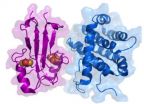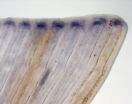(Press-News.org) HOUSTON – (March 27, 2014) – A new understanding of proteins at the nexus of a cell's decision to survive or die has implications for researchers who study cancer and age-related diseases, according to biophysicists at the Rice University-based Center for Theoretical Biological Physics (CTBP).
Experiments and computer analysis of two key proteins revealed a previously unknown binding interface that could be addressed by medication. Results of the research appear this week in an open-source paper in the Proceedings of the National Academy of Sciences.
The proteins are Bcl-2, well-known for its role in programmed cell death, and NAF-1, a member of the NEET family that binds toxic clusters of iron and sulfur. How the two interact is now known as a major determinant in the cell processes of autophagy and apoptosis -- literally, life and death. An ability to uncover binding sites on the proteins that send the cell one way or the other opens a path toward the regulation of those processes, according to José Onuchic, Rice's the Harry C. and Olga K. Wiess Chair of Physics and professor of physics and astronomy.
Pockets and folds in proteins exist to bind to other molecules and catalyze actions in a cell in signaling pathways. The ability to block a specific binding site or to enhance a desired interaction is critical to drug design, Onuchic said.
"In our early work we have shown the link between NEET proteins and cancer. Now we can understand the molecular details of how these interactions are governed," Onuchic said. "Others have shown that NAF-1 is up-regulated in cancer cells, which leads us to believe that cancer may hijack control over the expression of this protein. This affects the cell's system of checks and balances. Understanding NAF-1 gives us a better idea of how to approach treatment."
The researchers found that NAF-1 binds to two specific regions of the protein Bcl-2 and that Bcl-2 binds to the NAF-1 groove formed between the beta cap and iron-sulfur cluster binding domains; the strongest coupling is at the cluster binding domain and some contacts of interest are at the top of the beta-cap domain. Since the iron-sulfur cluster is the functional entity involved in NAF-1 activity, these findings clearly indicate that Bcl-2 interaction with NAF-1 affects its activity, Onuchic said.
The research team used a unique combination of experimental and theoretical methods, including peptide array binding studies with fragments of Bcl-2 to NAF-1; the researchers performed functional studies of cluster transfer and other full-length protein interactions with a spectrometer sensitive to hydrogen/deuterium exchange. They combined their results with a computer-based process created at CTBP called direct coupling analysis (DCA), through which interactions between proteins can be predicted by their genomic roots.
"Each of the three techniques not only confirmed the results of the other methods but also provided unique insights in their own right," said Patricia Jennings, a lead author and CTBP affiliate based at the University of California, San Diego (UCSD), where she is a professor of chemistry and biochemistry.
Jennings said the combined techniques are applicable to biomolecular interactions in general. "DCA helps us efficiently filter through massive amounts of data and does not require high-resolution structural studies, although those are desirable," she said. "Peptide array is powerful for localizing fragments that bind with high affinity, and hydrogen/deuterium exchange studies allow us to monitor parts of the intact protein that are not seen in structural studies and are not amenable to DCA analysis.
"Together, the techniques provide an exquisite synergy," she said.
Jennings is a co-lead author of the study with Onuchic; Rachel Nechushtai, a professor at the Alexander Siberman Life Science Institute of the Hebrew University of Jerusalem; Assaf Friedler, a professor at the Hebrew University Institute of Chemistry; and Ron Mittler, a professor of biological sciences at the University of North Texas, Denton (UNT). Previous research by the team identified NAF-1 as one of two prime suspects in the proliferation of breast cancer.
"Once again, our international team of experts from different disciplines has shown that combined complementary efforts leads to innovative knowledge imperative for coping with cancer," Nechushtai said.
INFORMATION:
Co-authors are Sagi Tamir, Shahar Rotem-Bamberger and Chen Katz of Hebrew University; Faruck Morcos, a postdoctoral researcher at Rice; and Kendra Hailey, John Zuris, Charles Wang, Andrea Conlan, Colin Lipper and Mark Paddock, all of UCSD.
The Israeli Science Foundation, the European Research Council under the European Community's Seventh Framework Program, the National Institutes of Health and the Cancer Prevention and Research Institute of Texas supported the research.
Read the paper at http://www.pnas.org/content/early/2014/03/24/1403770111.abstract
This news release can be found online at http://news.rice.edu/2014/03/27/cancer-researchers-find-key-protein-link/
Follow Rice News and Media Relations via Twitter @RiceUNews
Related Materials:
Center for Theoretical Biological Physics: https://ctbp.rice.edu
Images for download:
http://news.rice.edu/wp-content/uploads/2014/03/0331_PROTEINS-1-web.jpg
A combination of experimental and theoretical studies, in particular direct coupling analysis (DCA), revealed detailed interactions between NAF-1 (left) and Bcl-2 (right), two proteins involved in cellular life-and-death decisions. The green lines represent links between the proteins predicted by DCA.
http://news.rice.edu/wp-content/uploads/2014/03/0331_PROTEINS-2-web.jpg
A combination of experimental and theoretical studies, in particular direct coupling analysis, revealed detailed interactions between NAF-1 (magenta) and Bcl-2 (blue), two proteins involved in cellular life-and-death decisions. (Credit: Mark Paddock, Patricia Jennings/UCSD)
Located on a 300-acre forested campus in Houston, Rice University is consistently
ranked among the nation's top 20 universities by U.S. News & World Report. Rice has highly respected schools of Architecture, Business, Continuing Studies, Engineering, Humanities, Music, Natural Sciences and Social Sciences and is home to the Baker Institute for Public Policy. With 3,920 undergraduates and 2,567 graduate students, Rice's undergraduate student-to-faculty ratio is 6.3-to-1. Its residential college system builds close-knit communities and lifelong friendships, just one reason why Rice has been ranked No. 1 for best quality of life multiple times by the Princeton Review and No. 2 for "best value" among private universities by Kiplinger's Personal Finance. To read "What they're saying about Rice," go here.
Editor's note: Links to images for download appear at the end of this release.
David Ruth
713-348-6327
david@rice.edu
Mike Williams
713-348-6728
mikewilliams@rice.edu
Cancer researchers find key protein link
Discovery could lead to new medications, according to Rice University scientists
2014-03-27
ELSE PRESS RELEASES FROM THIS DATE:
Sleep may stop chronic pain sufferers from becoming 'zombies'
2014-03-27
Chronic pain sufferers could be kept physically active by improving the quality of their sleep, new research suggests.
The study by the University of Warwick's Department of Psychology, published in PLoS One, found that sleep was a worthy target for treating chronic pain and not only as an answer to pain-related insomnia.
"Engaging in physical activity is a key treatment process in pain management. Very often, clinicians would prescribe exercise classes, physiotherapy, walking and cycling programmes as part of the treatment, but who would like to engage in these activities ...
First sightings of solar flare phenomena confirm 3-D models of space weather
2014-03-27
Scientists have for the first time witnessed the mechanism behind explosive energy releases in the Sun's atmosphere, confirming new theories about how solar flares are created.
New footage put together by an international team led by University of Cambridge researchers shows how entangled magnetic field lines looping from the Sun's surface slip around each other and lead to an eruption 35 times the size of the Earth and an explosive release of magnetic energy into space.
The discoveries of a gigantic energy build-up bring us a step closer to predicting when and where ...
Corporate layoff strategies are increasing workplace gender and racial inequality
2014-03-27
Research from Prof. Alexandra Kalev of Tel Aviv University's Department of Sociology and Anthropology reveals that current workplace downsizing policies are reducing managerial diversity and increasing racial and gender inequalities. According to the study, layoff practices focusing on positions and tenure, rather than worker performance, minimized the share of white women in management positions by 25 percent and of black men by 20 percent. Prof. Kalev found that a striking two-thirds of the companies surveyed used tenure or position as their core criteria for downsizing. ...
Instituting a culture of professionalism
2014-03-27
Boston, MA—There is a growing recognition that in health care institutions where professionalism is not embraced and expectations of acceptable behaviors are not clear and enforced, an increase in medical errors and adverse events and a deterioration in safe working conditions can occur. In 2008 Brigham and Women's Hospital (BWH) created the Center for Professionalism and Peer Support (CPPS) and has seen tremendous success in this initiative. Researchers recently analyzed data from the CPPS from 2010 through 2013 and found that employees continue to turn to the center for ...
Controlling electron spins by light
2014-03-27
This news release is available in German.
The material class of topological insulators has been discovered a few years ago and displays amazing properties: In their inside, they behave electrically insulating but at their surface they form metallic, conducting states. The electron spin, i. e., their intrinsic angular momentum, is playing a decisive role. Their sense of rotation is directly coupled to their direction of movement. This coupling leads not only to a high stability of the metallic property but also enables a particularly lossless electrical conduction. ...
To grow or not to grow: a step forward in adult vertebrate tissue regeneration
2014-03-27
The reason why some animals can regenerate tissues after severe organ loss or amputation while others, such as humans, cannot renew some structures has always intrigued scientists. In a study now published in PLOS ONE*, a research group from Instituto Gulbenkian de Ciência (IGC, Portugal) led by Joaquín Rodríguez León provided new clues to solve this central question by investigating regeneration in an adult vertebrate model: the zebrafish. It was known that zebrafish is able to regenerate organs, and that electrical currents may play a role in this process, but the exact ...
Seasonal Arctic summer ice extent still hard to forecast, study says
2014-03-27
Scientists at the National Snow and Ice Data Centre (NSIDC), University College London, University of New Hampshire and University of Washington analysed 300 summer Arctic sea ice forecasts from 2008 to 2013 and found that forecasts are quite accurate when sea ice conditions are close to the downward trend that has been observed in Arctic sea ice for the last 30 years. However, forecasts are not so accurate when sea ice conditions are unusually higher or lower compared to this trend.
"We found that in years when the sea ice extent departed strongly from the trend, such ...
Four in 10 infants lack strong parental attachments
2014-03-27
PRINCETON, N.J.—In a study of 14,000 U.S. children, 40 percent lack strong emotional bonds — what psychologists call "secure attachment" — with their parents that are crucial to success later in life, according to a new report. The researchers found that these children are more likely to face educational and behavioral problems.
In a report published by Sutton Trust, a London-based institute that has published more than 140 research papers on education and social mobility, researchers from Princeton University, Columbia University, the London School of Economics and Political ...
GW researcher invents 'mini heart' to help return venous blood
2014-03-27
WASHINGTON (March 27, 2014) — George Washington University (GW) researcher Narine Sarvazyan, Ph.D., has invented a new organ to help return blood flow from veins lacking functional valves. A rhythmically contracting cuff made of cardiac muscle cells surrounds the vein acting as a 'mini heart' to aid blood flow through venous segments. The cuff can be made of a patient's own adult stem cells, eliminating the chance of implant rejection.
"We are suggesting, for the first time, to use stem cells to create, rather than just repair damaged organs," said Sarvazyan, professor ...
Clemson researcher touts surgical safety checklist to save lives
2014-03-27
Clemson University research assistant professor Ashley Kay Childers has been selected to participate in a forum to discuss quality improvement programs in U.S. hospitals that reduce preventable readmissions, prevent medical errors, improve patient outcomes and cut costs.
Childers, who also is a member of the South Carolina Hospital Association (SCHA) Quality and Patient Safety team, will participate in the American College of Surgeons (ACS) Surgical Health Care Quality Forum South Carolina in Columbia April 1.
The forum will focus on Childers' work with the Safe Surgery ...
LAST 30 PRESS RELEASES:
Numbers in our sights affect how we perceive space
SIMJ announces global collaborative book project in commemoration of its 75th anniversary
Air pollution exposure and birth weight
Obstructive sleep apnea risk and mental health conditions among older adults
How talking slows eye movements behind the wheel
The Ceramic Society of Japan’s Oxoate Ceramics Research Association launches new international book project
Heart-brain connection: international study reveals the role of the vagus nerve in keeping the heart young
Researchers identify Rb1 as a predictive biomarker for a new therapeutic strategy in some breast cancers
Survey reveals ethical gaps slowing AI adoption in pediatric surgery
Stimulant ADHD medications work differently than thought
AI overestimates how smart people are, according to HSE economists
HSE researchers create genome-wide map of quadruplexes
Scientists boost cell "powerhouses" to burn more calories
Automatic label checking: The missing step in making reliable medical AI
Low daily alcohol intake linked to 50% heightened mouth cancer risk in India
American Meteorological Society announces Rick Spinrad as 2026 President-Elect
Biomass-based carbon capture spotlighted in newly released global climate webinar recording
Illuminating invisible nano pollutants: advanced bioimaging tracks the full journey of emerging nanoscale contaminants in living systems
How does age affect recovery from spinal cord injury?
Novel AI tool offers prognosis for patients with head and neck cancer
Fathers’ microplastic exposure tied to their children’s metabolic problems
Research validates laboratory model for studying high-grade serous ovarian cancer
SIR 2026 delivers transformative breakthroughs in minimally invasive medicine to improve patient care
Stem Cell Reports most downloaded papers of 2025 highlight the breadth and impact of stem cell research
Oxford-led study estimates NHS spends around 3% of its primary and secondary care budget on the health impacts of heat and cold in England
A researcher’s long quest leads to a smart composite breakthrough
Urban wild bees act as “microbial sensors” of city health.
New study finds where you live affects recovery after a hip fracture
Forecasting the impact of fully automated vehicle adoption on US road traffic injuries
Alcohol-related hospitalizations from 2016 to 2022
[Press-News.org] Cancer researchers find key protein linkDiscovery could lead to new medications, according to Rice University scientists






